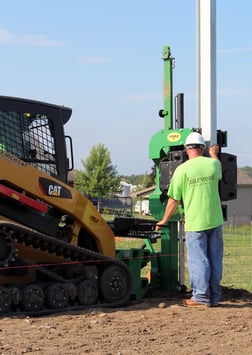As the Vice President of Operations here at Harvest Energy Solutions I am responsible for the system design, product identification, purchasing and construction of the solar arrays.
Here at Harvest Energy Solutions we have in-house designers, engineers, installers, licensed electrician and solar technicians to complete each one of our projects. Each system is unique in itself and we are dedicated to working closely with each customer to ensure a smooth process start to finish. Each project begins with a site review to make sure that the areas are clear and soil characteristics, grading, and drainage have been accounted for on the property for a ground mounted system. Once the site is approved and the permits have been completed, the posts for the array can be pounded in and the racking structure for the solar panels will be built. The individual solar panels are installed and connected to the inverter. Most projects only take a few days (depending on size) to complete and after the final inspection is approved your interconnection can go live and you able to start producing your own energy.

Below I have included a few in-depth term descriptions:
An inverter is any device that inverts DC (direct current) into AC (alternating current). In a solar installation, an inverter is a centralized device that connects to and manages the performance of the solar panel array; it aggregates the DC power coming from the panels or strings of panels and inverts the DC power into single phase (or three phase) AC power at the correct voltage for delivery into the users electrical system and provides equipment protection and safety features. The better inverters on the market also allow for data logging and web-based remote monitoring of important performance metrics and power generation.
With a grid-tied system, local power company regulations must be met, and each area is different. Otherwise, the system will include the panels, mounting hardware, connecting wires, and an inverter to convert the DC power from the panels into the correct AC voltage.
DC or Direct Current is defined as the “unidirectional” flow of current; current only flows in one direction. AC or Alternating Current describes the flow of charge that changes direction periodically. As a result, the voltage level also reverses along with the current.
Interconnection refers to the standards and requirements that govern how you can connect your solar panel system to the grid. It’s not as simple as your current one-way connection, because the electricity from your panels needs to be converted and transmitted based on how much you generate at any given time. It determines the responsibilities of utility companies and homeowners in the interconnection process.
Racking is the mounting systems that are used to fix solar panels on surfaces like roofs, building facades, or the ground.



